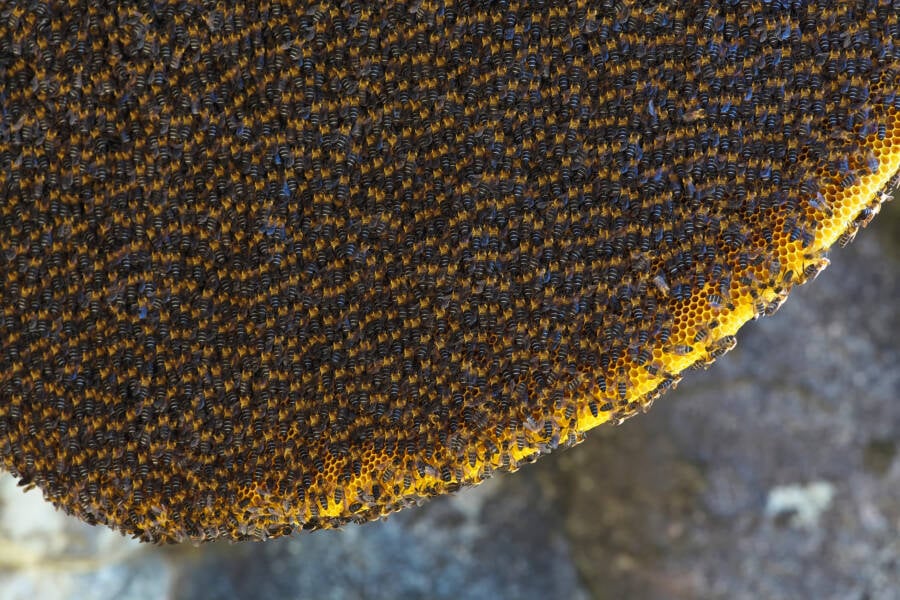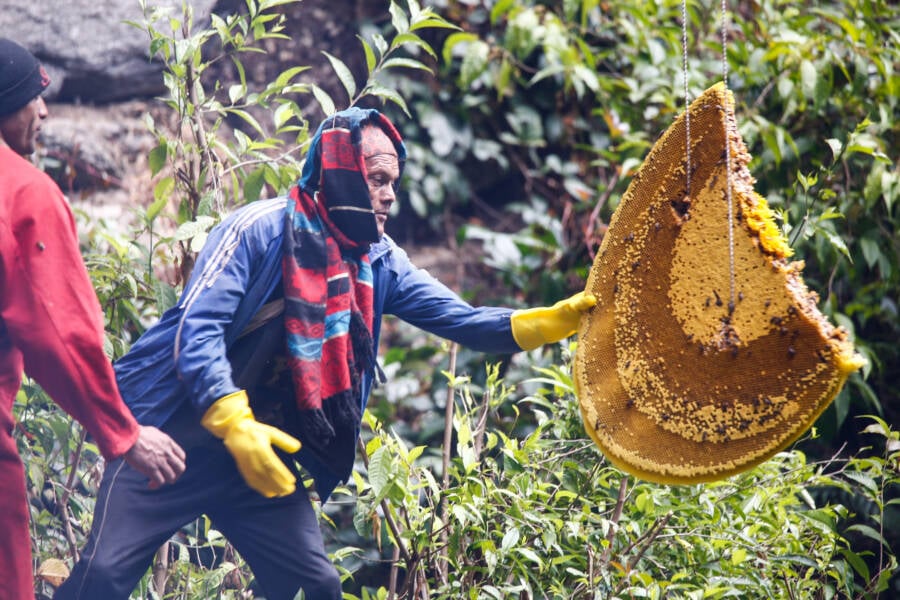One of a kind and positively euphoric, mad honey has been around for centuries, but its intense psychedelic properties have made it illegal to purchase in some nations today.

Nature Picture Library/Alamy Stock PhotoMad honey is made by Himalayan giant honey bees, the world’s largest honey bees.
Hidden high up in the Himalayan mountains of Nepal and in the Black Sea region of Turkey is a psychedelic substance known as “mad honey.” This unusual elixir is made by the world’s largest honey bees, Apis laboriosa, which feed on native rhododendron plants containing neurotoxins that give the honey its psychoactive effects.
To reach the remote beehives where the honey is produced, hunters climb hundreds of feet up steep cliffs, often with little protective clothing while suffering untold numbers of painful bee stings. Those who eat it may experience dizziness, disorientation, euphoria, and even hallucinations, and many have used it as a spiritual aid to achieve deeper awareness and insight.
Dive into the origins of mad honey to see why this mystical substance has become a hot commodity today.
The Psychedelic History Of Mad Honey

Wikimedia CommonsMad honey can be found in the mountains of Nepal and Turkey.
People have enjoyed the psychedelic properties of mad honey for at least 2,400 years. One of the earliest recorded encounters with this substance comes from Xenophon, a Greek military leader and commander of one of the largest mercenary armies of the Achaemenid Empire.
According to Big Think, Xenophon mentions the honey in his book “Anabasis,” in which he writes of a peculiar situation his army faced in 401 B.C.E. after consuming honeycombs in the Turkish city of Trabzon.
Apparently, the honey caused many of the soldiers to experience a bad trip, making them sick and extremely disoriented. Xenophon notes that some of them lay on the ground in “general dejection” for several days.
“The number of bee-hives was extraordinary, and all the soldiers that ate of the combs, lost their senses, vomited, and were affected with purging, and none of them were able to stand upright,” Xenophon wrote. “Such as had eaten only a little were like men greatly intoxicated, and such as had eaten much were like mad-men, and some like persons at the point of death.”
A similar encounter took place years later, in 67 B.C.E., when Pompey the Great and his Roman army were chasing Persian troops along the Black Sea. Knowing the Romans were on their tail, the Persian army intentionally left behind pots full of mad honey for the Roman army to find and indulge in. After eating it, the Romans became so disoriented that the Persians handily defeated them, killing over 1,000 Roman troops.
But for the people who understand mad honey best, its effects can be incredibly spiritual and healing.
The Ancient Tradition Of Honey Hunting

ZUMA Press, Inc./Alamy Stock PhotoHoney hunters climb hundreds of feet to reach the hives.
For the Gurung people of Central Nepal, where mad honey is abundant, honey hunting has been a centuries-long tradition. For generations, they have used this substance for medicinal remedies as well as spiritual purposes. In fact, the honey hunters of Gurung risk their lives every year to extract the honey from the Himalayan cliffs.
To reach this rare prize, honey hunters climb rope ladders hundreds of feet up steep cliffs to find the beehives where it’s produced. After first sedating the bees with smoke, they use long bamboo sticks to remove the hives from the cliff walls and then drop them into a basket below, all the while remaining calm despite enduring painful bee stings.

ZUMA Press, Inc./Alamy Stock PhotoA honey hunter harvesting mad honey from a cliffside in Nepal.
After the honey has been extracted, those present for the hunt gather around to share and enjoy it. That’s when its unusual effects kick in.
The Risks And Benefits Of Taking Mad Honey
While traditional honey offers several medicinal benefits, like acting as an anti-inflammatory agent and easing sore throats, mad honey takes it a step further.
According to a study published in the journal RSC Advances, mad honey has been employed as an alternative treatment for conditions like diabetes, gastrointestinal disorders, and arthritis. This substance is also said to enhance physical and mental performance and serve as a powerful aphrodisiac.
Because mad honey contains the active compound grayanotoxin, it can also act as a psychedelic. Those who eat it may experience euphoria and even hallucinations. Some who’ve indulged in mad honey have reported feeling less stressed and more in-tune with their surroundings.

L. Shyamal/Wikimedia CommonsHimalayan giant honey bees feed on rhododendron plants, which contain the neurotoxins that give mad honey its psychoactive properties.
Though these effects may seem enticing, it’s crucial to note that consuming mad honey also comes with significant risks.
Grayanotoxin, the same ingredient that causes mad honey’s hallucinogenic effects, can also cause disorientation, dizziness, nausea, vomiting, low blood pressure, loss of muscle control, irregular heart beat, and even temporary paralysis, depending on both the amount of honey you consume and your individual sensitivity.
However, while these reactions can last up to 24 hours, mad honey poisoning is very rarely fatal. Still, anyone interested in trying it should research the potential health risks and consume with caution.
Mad Honey’s Rise In Popularity

ZUMA Press, Inc./Alamy Stock PhotoHoney hunters typically leave behind a third of the hive so bees can repopulate it for the next season.
While honey hunting is a centuries-old tradition in the Himalayas, in recent years this substance has become sought after in certain circles in the West because of its mind-altering effects. Due to this global spike in interest, mad honey is now available to purchase via a number of online stores.
While mad honey is legal in the U.S., many countries have banned it due to its intense psychoactive properties. As a result, it has also appeared on the black market, where it can go for close to $60 to $80 per pound.
Whether you’re curious about mad honey’s medicinal properties or looking to have a spiritual adventure, experts recommend that anyone interested in sampling this natural elixir buy it from a verified seller to ensure a safe experience.
After learning about the origins and hallucinogenic properties of mad honey, read about the trippy history of peyote. Then, learn about Morgan Freeman’s efforts to save America’s honey bees by converting his ranch into a bee sanctuary.






